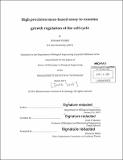| dc.contributor.advisor | Scott R. Manalis. | en_US |
| dc.contributor.author | Gulati, Amneet | en_US |
| dc.contributor.other | Massachusetts Institute of Technology. Department of Biological Engineering. | en_US |
| dc.date.accessioned | 2014-09-19T21:42:32Z | |
| dc.date.available | 2014-09-19T21:42:32Z | |
| dc.date.copyright | 2014 | en_US |
| dc.date.issued | 2014 | en_US |
| dc.identifier.uri | http://hdl.handle.net/1721.1/90147 | |
| dc.description | Thesis: Ph. D., Massachusetts Institute of Technology, Department of Biological Engineering, 2014. | en_US |
| dc.description | Cataloged from PDF version of thesis. | en_US |
| dc.description | Includes bibliographical references (pages 104-111). | en_US |
| dc.description.abstract | Studying biophysical properties of cells can provide insight into the metabolic mechanisms and regulation of cell cycle processes. Though size is considered to be a fundamental property of cell state, its measurement on a single-cell basis with high-resolution has been elusive primarily due to enormous experimental barriers. This thesis discusses the use of a cantilever based suspended microchannel resonator (SMR) to measure mass, and resistive pulse based Coulter counter to measure volume. First, we discuss the implementation of several engineering principles that have enabled the SMR to measure size with a high precision and temporal resolution. As a result, growth rates can now be estimated at a single-cell basis with unprecedented precision of ~170 fg.hr-¹. Second, we employ the SMR to investigate the coordination between the fundamental processes of cell growth and cell division cycle. Contrary to the reigning 60-yr old hypothesis of a deterministic size-control of the cell cycle, it is observed that cells display significant size variability at the Start checkpoint of the cell cycle. Furthermore, the measurements find only a weak size-control on the time spent in G1. Remarkably, it is observed that the cell's initial growth rate is a significantly better predictor of G1 duration than its initial size. Third, we develop a method to enable continuous, long-term volume measurement. Based on a commercial Coulter counter device, it provides a complementary technique for high-throughput measurement and continuous sampling of cell volume, as well volumetric growth rate on a population-scale. | en_US |
| dc.description.statementofresponsibility | by Amneet Gulati. | en_US |
| dc.format.extent | 113 pages | en_US |
| dc.language.iso | eng | en_US |
| dc.publisher | Massachusetts Institute of Technology | en_US |
| dc.rights | MIT theses are protected by copyright. They may be viewed, downloaded, or printed from this source but further reproduction or distribution in any format is prohibited without written permission. | en_US |
| dc.rights.uri | http://dspace.mit.edu/handle/1721.1/7582 | en_US |
| dc.subject | Biological Engineering. | en_US |
| dc.title | High precision mass-based assay to examine growth regulation of the cell cycle | en_US |
| dc.type | Thesis | en_US |
| dc.description.degree | Ph. D. | en_US |
| dc.contributor.department | Massachusetts Institute of Technology. Department of Biological Engineering | |
| dc.identifier.oclc | 890197473 | en_US |
